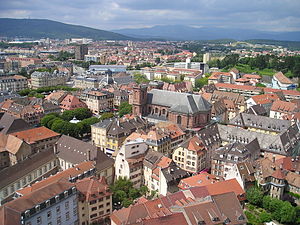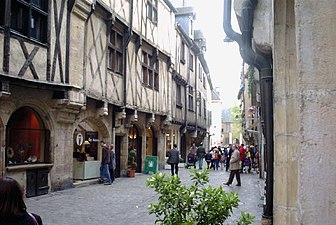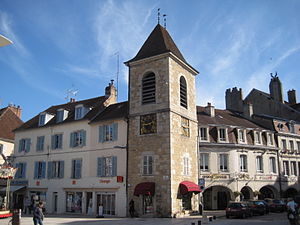| |||
| Burgundy-Franche-Comté region | |||
| Capital | Dijon, Besançon | ||
|---|---|---|---|
| Residents | 2.807.807 (2018) | ||
| surface | 47,784 km² | ||
| no tourist info on Wikidata: | |||
| location | |||
 | |||
Burgundy Franche Comté (French Bourgogne-Franche-Comté) is one of the 13 administrative regions newly cut in 2016 in metropolitan France. It is located in the east of France and consists of the former regions Burgundy and Franche-Comté. Burgundy-Franche-Comté borders on the east Switzerland (Cantons law, Neuchâtel and Vaud). In France, the border is clockwise Auvergne-Rhône-Alpes in the south, Center-Val de Loire in the West, Île-de-France in the northwest and Grand Est in the North. For the purposes of this travel guide, the administrative region is divided into two travel regions:
Regions


places
- 1 Auxerre
 - Partly preserved medieval old town with half-timbered houses, abbey and cathedral; Origin of the white wine grape variety Auxerrois
- Partly preserved medieval old town with half-timbered houses, abbey and cathedral; Origin of the white wine grape variety Auxerrois - 2 Belfort
 - is the prefecture (administrative seat) of the Territoire de Belfort department
- is the prefecture (administrative seat) of the Territoire de Belfort department - 3 Besançon
 - is the prefecture (administrative seat) of the Doubs department. The Poudrey Gorge, the Dino Zoo, the grottes d'Osselle, Arc-et-Senans, Quingey
- is the prefecture (administrative seat) of the Doubs department. The Poudrey Gorge, the Dino Zoo, the grottes d'Osselle, Arc-et-Senans, Quingey
Auxerre

Belfort

Besançon
- 4 Chalon-sur-Saône
 - Birthplace of photography
- Birthplace of photography - 5 Dijon
 - Capital of the Burgundy region, known worldwide for mustard and currant liqueur, but also a very interesting city rich in history
- Capital of the Burgundy region, known worldwide for mustard and currant liqueur, but also a very interesting city rich in history - 6 Dole
 - historical capital of Franche-Comté, sub-prefecture and largest city in the Jura, with an important historical and cultural heritage.
- historical capital of Franche-Comté, sub-prefecture and largest city in the Jura, with an important historical and cultural heritage.

Chalon-sur-Saône

Dijon

Dole
- 7 Lons-le-Saunier
 - is the prefecture (administrative seat) of the Jura department, has a cultural heritage related to the salt pans and has a thermal bath.
- is the prefecture (administrative seat) of the Jura department, has a cultural heritage related to the salt pans and has a thermal bath. - 8 Nevers
 - is the prefecture (administrative seat) of the Nièvre département, a beautiful old town with town houses from the 14th to 17th centuries, remains of the medieval town fortifications and the ducal castle; The center of faience art, the Magny-Cours race track is a meeting point for motorsport fans
- is the prefecture (administrative seat) of the Nièvre département, a beautiful old town with town houses from the 14th to 17th centuries, remains of the medieval town fortifications and the ducal castle; The center of faience art, the Magny-Cours race track is a meeting point for motorsport fans - 9 Vesoul
 - is the prefecture (administrative seat) of the Haute-Saône department
- is the prefecture (administrative seat) of the Haute-Saône department

Lons-le-Saunier

Nevers

Vesoul
Other goals
background
The entire area formed the heart of the kingdom and later of the Duchy of Burgundy for 1000 years in the Middle Ages, but became part of the French state from the 15th century. In 2016, the two regions of Burgundy and Franche-Comté voluntarily merged to form today's Bourgogne-Franche-Comté as part of a national territorial reform. They were the only two regions that had bilaterally expressed a desire to unite before the national law was passed, likely due to their strong historical ties.
Burgundy and Franche-Comté have a rich architectural heritage with notable buildings including castles and important Romanesque and Gothic cathedrals. The region's vineyards are some of the most prestigious in the world, with the Burgundian wine region including Beaujolais and Chablis. Aside from the cities and towns, many of which are walled, the landscape is criss-crossed by numerous charming and picturesque villages.
The region also offers natural beauties. Burgundy has lakes and forests and offers numerous opportunities for fishing, hiking or horse riding. The Loire is bordered by rolling hills covered with vineyards. The Nièvre has an extensive wild landscape that is suitable for both sporting and cultural activities. The Jura is a wooded low mountain range with many gorges, caves and rock peaks, which gave the Jura period its name.
language
getting there
mobility
Tourist Attractions
Many villages in the region have old medieval town centers. Just wander around and look around, find a bar, have a glass of wine and soak up the atmosphere; there are hundreds of castles and palaces in Burgundy. Many of them can be visited.
- Two historical salt production sites in the region are on the UNESCO list of world cultural heritage:
- The royal saltworks Arc-et-Senans is located about 35 km southwest of Besançon in the Rhône ditch. It was founded in 1775 and was finally shut down in 1962. The salt was obtained in open brewing kettles. The importance of the salt works also lies in the planning to expand the salt works into an ideal city.
- The salt works of Salins-les-Bains
activities
- L'Echappée jurassienne is the main hiking route of the Jura. It connects the plains of Dole with the heights of the Les Rousses ski area. On 260 km of hiking trails you can wander through forests, discover the Grande Saline and Saline Royale salt pans, which have been declared a World Heritage Site by UNESCO, vineyards, refreshing lakes and waterfalls as well as spectacular landscapes that are characterized by a special geology. You can hike from a few hours to two weeks or more.
kitchen
Bourgogne-Franche-Comté is home to many dishes that have become synonymous with French cuisine around the world; the best of them use local wine as their main ingredient.
Regional specialities
- Beef Bourguignon - beef stewed with wine for hours. In the past, the meat of old farm animals was used. In the meantime the ox tractors have given way, which is why the Burgundy roast has also become rare.
- Coq au vin - Chicken with mushrooms and herbs in a red wine sauce
- Escargots de Bourgogne - Snails with herbs and garlic butter. Not only do the grapes grow in the vineyards, but also a myriad of Roman snails. Prepared the Burgundy way, they are a delicacy.

Beef Bourguignon
_02.jpg/220px-Coq_au_vin_(Bourgogne)_02.jpg)
Coq au vin

Burgundy snails
- Jambon persillé - Ham and parsley terrine and white Bourgogne Aligoté wine
- Gougères - Cheese balls
- Moutarde de Dijon - The typical French mustard no longer comes from Dijon, but is produced in neighboring Chevigny-Saint-Sauveur
- Anise de Flavigny - Candy made from anise and coated with sugar syrup
nightlife
security
climate
literature
Web links
https://www.bourgognefranchecomte.fr/ - Official website of Bourgogne-Franche-Comté

.svg/100px-Flag_of_the_region_Bourgogne-Franche-Comté_(fixed).svg.png)




















_02.jpg/220px-Coq_au_vin_(Bourgogne)_02.jpg)

